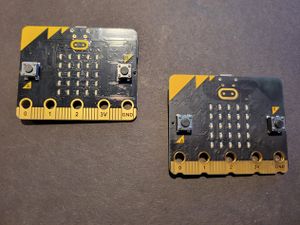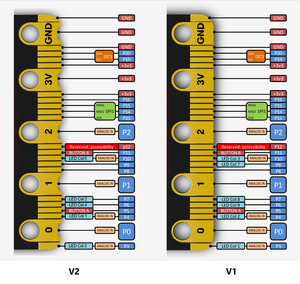Micro:bit
The micro:bit is a small programmable computer developed for education and experimentation. It was created by the BBC to encourage coding and digital skills in young people.
There are two versions of the micro:bit: version 1 and version 2. Both versions are similar in many ways, but there are some key differences between the two.
v1
Overall, the micro:bit v1 is a small and affordable device designed for education and experimentation in programming and electronics. Its compact size, variety of sensors and input/output options, and wireless capabilities make it a versatile tool for a wide range of projects.
- Processor: 16MHz ARM Cortex-M0
- Memory: 16KB RAM, 256KB Flash
- Wireless: Bluetooth Low Energy (BLE)
- Sensors: Compass, Accelerometer, and Temperature sensor
- Input/Output: 5x5 LED matrix display, 2 programmable buttons, 3 analog input/output rings, 20-pin edge connector for additional accessories
- Power: Micro USB connector for power and programming, or 2 AAA batteries (not included)
v2
Compared to the micro:bit v1, the v2 has a more powerful processor, more memory, and additional features such as a microphone, speaker, touch-sensitive logo, and capacitive touch sensor. These enhancements make the micro:bit v2 more capable of handling complex tasks and enable more advanced projects and experimentation with sound and touch-based interactions.
- Processor: 64MHz ARM Cortex-M4
- Memory: 512KB RAM, 2MB Flash
- Wireless: Bluetooth Low Energy (BLE)
- Sensors: Compass, Accelerometer, and Temperature sensor
- Input/Output: 5x5 LED matrix display, 2 programmable buttons, touch-sensitive logo, capacitive touch sensor, 25-pin edge connector for additional accessories
- Sound: Speaker and microphone
- Power: Micro USB connector for power and programming, or 2 AAA batteries (not included)
Despite these differences, both versions of the micro:bit are great tools for learning to code and experimenting with electronics. They are easy to use, affordable, and come with a range of resources and tutorials to help beginners get started.


